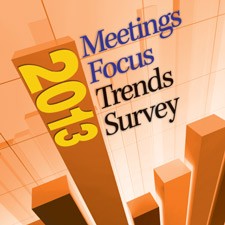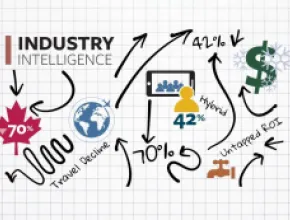More than 600 planners completed our annual Meetings Focus Trends Survey this year, revealing that prices continue to cause consternation and the stubbornly sluggish economy tops their list of threats to the meetings industry.
Expert Opinions
Two hospitality industry experts were interviewed for this article: Bjorn Hanson, dean of the Tisch Center for Hospitality, Tourism and Sports; and Bobby Bowers, senior vice president of operations for consultancy Smith Travel Research.
In a nutshell, both experts believe the greatly anticipated recovery of the hospitality industry is under way, but that success fluctuated greatly depending on the specific market. Demand, even though relatively low, is outpacing supply at least for the moment in many top-tier destinations, which in some cases is due to anemic growth in the hotel pipeline over the past few years.
| What will be your biggest challenge when planning meetings in the coming year? | Rate-of-change (2011 vs. 2012) | |||||||||
| Total % | Assoc. % | Corp. % | Gov. % | Ind. % | Total % | Assoc. % | Corp. % | Gov. % | Ind. % | |
| Lower budget | 29.5 | 16.1 | 36.5 | 60.0 | 32.0 | -5.3 | -5.9 | -4.4 | 2.6 | -2.8 |
| Declining attendance | 19.2 | 29.0 | 10.3 | 10.0 | 19.9 | 1.2 | 1.6 | -0.1 | -6.4 | 2.2 |
| Decreasing staff | 3.6 | 4.5 | 3.0 | 6.7 | 2.8 | NA | NA | NA | 6.7 | 2.8 |
| Increasing costs (hotels, suppliers, etc.) | 38.2 | 44.6 | 36.5 | 13.3 | 36.5 | 1.1 | 2.0 | -0.7 | -4.7 | 0.3 |
| More transportation difficulties | 1.3 | 0.4 | 2.6 | 0.0 | 1.1 | -0.6 | -0.4 | -0.4 | -1.6 | -0.6 |
| Other | 8.2 | 5.4 | 11.2 | 10.0 | 7.7 | 0.0 | -1.8 | 2.6 | 3.4 | -1.9 |
| What do you believe is the biggest threat to the meetings industry? | Rate-of-change (2011 vs. 2012) | |||||||||
| Total % | Assoc. % | Corp. % | Gov. % | Ind. % | Total % | Assoc. % | Corp. % | Gov. % | Ind. % | |
| The economy | 59.3 | 59.9 | 62.1 | 58.6 | 55.2 | -10.4 | -14.6 | -9.9 | -10.2 | -6.9 |
| Fuel prices | 3.6 | 4.5 | 1.7 | 0.0 | 5.5 | 1.9 | 2.8 | 0.2 | -1.6 | 3.4 |
| Airline issues (fares, lift, service, etc.) | 9.2 | 7.7 | 9.9 | 0.0 | 11.6 | 2.2 | 2.6 | 2.5 | -4.9 | 2.8 |
| Virtual meetings | 9.5 | 10.8 | 8.2 | 3.4 | 10.5 | -0.6 | 3.2 | -1.9 | -4.7 | -2.5 |
| Perceived value of profession | 13.4 | 12.2 | 15.1 | 24.1 | 11.0 | 5.2 | 3.2 | 8.7 | 15.9 | 1.4 |
| Perceived value of meetings, ROI | 0.9 | 0.9 | 0.4 | 0.0 | 1.7 | NA | NA | NA | NA | NA |
| Government regulations | 1.2 | 1.4 | 1.3 | 6.9 | 0.0 | NA | NA | NA | NA | NA |
| Low budget/funds | 0.3 | 0.0 | 0.0 | 0.0 | 1.1 | NA | NA | NA | NA | NA |
| Other | 2.6 | 2.7 | 1.3 | 6.9 | 3.3 | -0.6 | 0.6 | -1.3 | -1.3 | -0.9 |
“About 40 percent of what’s under construction is in those [top 10 markets], and a lot of the other parts of the country are not going to see a lot of it,” Bowers says. “We think demand growth will be slower, and some of that has to do with the fact that we had a pretty good growth rate in 2012. It really depends on the market, because it’s really a street-corner business.”
Bowers points to San Francisco and New York being particularly strong in 2012, and looks for their boom to continue in 2013. Planners can expect to see bargains in major metros such as Atlanta and Dallas, which saw massive room growth in 2008 and 2009; Phoenix and Washington, D.C. According to Bowers, Nashville, which is opening a huge convention center with a new Omni hotel next to it, could also be a bargain. In general, Midwestern metros such as Detroit, Cincinnati and Kansas City may also be value leaders.
Hanson believes that the slow rate in supply growth will be eclipsed slightly by a slightly better growth in demand in 2013. PageBreak
“The headlines will be much more positive than the underlying fundamentals next year for the whole lodging industry in the U.S.,” Hanson contends, “and RevPAR [revenue per available room] will increase maybe 5.5 percent, but it is happening with demand growth of only 1.5 percent, compared to a long-term demand growth of 2.1 percent. The reason for the positive headlines is that the supply growth is even slower than the demand growth.”
Hanson expects a 4.5 percent to 5 percent growth in ADR (average daily room rate), and that the growth of meeting demand for hotel rooms will register close to a 2 percent increase.
“What does this mean for rates for meetings? To the extent that meeting planners need to schedule meetings during peak demand periods in tier-one markets, the rate increase will be significantly above average,” Hanson says, adding that groups planning in peak periods could see price increases from 5 percent to 10 percent, but planners who are more flexible with their time and location can expect a smaller, 2.5 percent to 5 percent price hike.
“It has maybe never been more challenging to be a convention planner, because of this variation,” Hanson emphasizes, “so other options are finding ways to shorten meetings, say from four days to three days, to have one less planned or organized meal, to have more buffets or box lunches, and maybe eliminate some of the packaged services available. …Meeting planners are focused not only on the room rate, but many other meeting expenses as well.”
| Do public perception issues regarding meetings affect your choice of destinations? | Rate-of-change (2011 vs. 2012) | |||||||||
| Total % | Assoc. % | Corp. % | Gov. % | Ind. % | Total % | Assoc. % | Corp. % | Gov. % | Ind. % | |
| Yes | 37.8 | 39.5 | 36.4 | 58.6 | 34.3 | -18.4 | -6.7 | -22.1 | -12.1 | -25.6 |
| No | 62.2 | 60.5 | 63.6 | 41.4 | 65.7 | 18.4 | 6.7 | 22.1 | 12.1 | 25.6 |
| Do public perception issues regarding meetings affect your choice of facilities? | Rate-of-change (2011 vs. 2012) | |||||||||
| Total % | Assoc. % | Corp. % | Gov. % | Ind. % | Total % | Assoc. % | Corp. % | Gov. % | Ind. % | |
| Yes | 37.9 | 38.4 | 37.4 | 65.5 | 33.5 | -18.2 | -6.9 | -21.3 | -11.1 | -25.0 |
| No | 62.1 | 61.6 | 62.6 | 34.5 | 66.5 | 18.2 | 6.9 | 21.3 | 11.1 | 25.0 |
| What do you think the typical duration of your meetings will be in 2013? | Rate-of-change (2011 vs. 2012) | |||||||||
| Total % | Assoc. % | Corp. % | Gov. % | Ind. % | Total % | Assoc. % | Corp. % | Gov. % | Ind. % | |
| Longer | 3.8 | 3.1 | 2.2 | 6.7 | 6.0 | 1.5 | 1.4 | -0.1 | 3.4 | 3.5 |
| Shorter | 8.1 | 4.9 | 9.5 | 10.0 | 9.9 | -3.6 | -4.4 | -2.5 | -3.1 | -3.8 |
| About the same | 88.1 | 91.9 | 88.3 | 83.3 | 84.1 | 2.1 | 2.9 | 2.6 | -0.3 | 0.3 |
| How have hybrid (live events combined with online events) meetings affected your live meetings? | Rate-of-change (2011 vs. 2012) | |||||||||
| Total % | Assoc. % | Corp. % | Gov. % | Ind. % | Total % | Assoc. % | Corp. % | Gov. % | Ind. % | |
| Decreased number of live attendees | 9.0 | 6.3 | 7.7 | 6.7 | 14.3 | -0.4 | -0.5 | 0.2 | -4.8 | 0.4 |
| Increased number of live attendees that would not have attended before | 6.7 | 6.3 | 6.0 | 16.7 | 6.6 | 1.9 | 3.3 | 1.1 | 10.1 | 0.3 |
| No effect | 30.9 | 30.8 | 33.9 | 43.3 | 25.3 | 3.9 | 7.5 | 1.7 | 23.7 | -1.3 |
| I have not planned a hybrid meeting | 53.4 | 56.7 | 52.4 | 33.3 | 53.8 | -5.4 | -10.3 | -3.1 | -29.0 | 0.7 |
Key Survey Findings
Economic woes remained the most worrisome industry stressor—about 60 percent of meeting planners across all segments placed the shaky financial condition of the U.S. on the top of their list of fears.
Respondents also noted that the perceived value of the profession is a threat to the meetings industry. This response showed a healthy increase across all segments and was listed by nearly one quarter of government planners; up nearly 16 percent in this year’s survey.
Airline issues represented the biggest fear for about 10 percent of respondents, and increased between 2 percent and 3 percent in every segment except government planners, which decreased by nearly 5 percent this year. PageBreak
Challenging Terrain
While the economy and professional clout topped the worry list of respondents when it comes to the meetings industry as a whole, lower budgets and increasing costs were the items that hit closest to home on a personal level.
Although more than 30 percent of corporate and independent planners listed a lower budget as what they expect to be the biggest challenge to their job next year, only 16 percent of association planners thought it would be their paramount concern.
A depressing 60 percent of government planners expect to have fewer financial resources to work with in 2013. The number of planners who put decreasing budgets as their biggest challenge is on the wane, however.
Increasing costs were a chief concern for a healthy number of respondents across all segments, but only registered with a little more than 13 percent of government planners.
| Are you planning, or do you expect to plan, a meeting with a corporate social responsibility (CSR) element during the next year? | Rate-of-change (2011 vs. 2012) | |||||||||
| Total % | Assoc. % | Corp. % | Gov. % | Ind. % | Total % | Assoc. % | Corp. % | Gov. % | Ind. % | |
| Yes | 28.9 | 21.4 | 29.9 | 25.0 | 37.4 | 2.1 | 3.3 | -0.6 | 6.7 | 3.5 |
| No | 71.1 | 78.6 | 70.1 | 75.0 | 62.6 | -2.1 | -3.3 | 0.6 | -6.7 | -3.5 |
| How has the planning of your meetings changed in the past year? | Rate-of-change (2011 vs. 2012) | |||||||||
| Total % | Assoc. % | Corp. % | Gov. % | Ind. % | Total % | Assoc. % | Corp. % | Gov. % | Ind. % | |
| Fewer days per meeting | 15.3 | 7.7 | 18.2 | 27.6 | 19.1 | -1.2 | -5.9 | 3.0 | 5.2 | -0.5 |
| Fewer meetings | 22.7 | 12.6 | 24.2 | 37.9 | 30.6 | -5.1 | -5.2 | -3.9 | 1.7 | -4.9 |
| Greater emphasis on ROI | 24.4 | 20.7 | 26.4 | 10.3 | 28.4 | 1.2 | 0.8 | 0.6 | -8.6 | 4.1 |
| Increased workload due to reduced staffing | 31.0 | 27.5 | 32.5 | 27.6 | 33.9 | -5.0 | -10.7 | -3.3 | -13.8 | 1.0 |
| Less entertainment | 16.7 | 14.4 | 19.0 | 17.2 | 16.4 | -4.2 | 3.0 | -5.7 | 10.3 | -7.1 |
| More complicated contract negotiations | 27.4 | 28.8 | 24.2 | 31.0 | 29.0 | -3.0 | -5.9 | -3.9 | 6.9 | -1.0 |
| More concern with disaster perparedness/security | 9.5 | 9.0 | 9.1 | 10.3 | 10.4 | -0.8 | -0.7 | 0.0 | 0.0 | -1.6 |
| More meeting sessions per day | 11.3 | 15.8 | 10.0 | 6.9 | 8.2 | 1.0 | 5.6 | -0.3 | -5.2 | -1.6 |
| No change | 23.9 | 30.2 | 22.9 | 10.3 | 19.7 | 0.9 | 6.5 | 0.5 | -17.2 | -2.1 |
| Other | 3.2 | 3.2 | 2.6 | 13.8 | 2.2 | -0.6 | -1.1 | -1.6 | 8.6 | -0.4 |
| Reduced budgets | 0.8 | 0.0 | 1.7 | 0.0 | 0.5 | NA | NA | NA | NA | NA |
| In general, how has attendance at the meetings and events you have held in the past 12 months changed? | Rate-of-change (2011 vs. 2012) | |||||||||
| Total % | Assoc. % | Corp. % | Gov. % | Ind. % | Total % | Assoc. % | Corp. % | Gov. % | Ind. % | |
| Decreased by more than 10% | 8.0 | 7.6 | 6.2 | 6.9 | 11.0 | -2.2 | -4.8 | -0.3 | 1.9 | -2.6 |
| Decreased up to 10% | 23.6 | 28.3 | 16.4 | 31.0 | 25.8 | 2.2 | 5.2 | -0.5 | 6.0 | 2.0 |
| No change | 39.4 | 34.5 | 43.8 | 37.9 | 40.1 | -7.4 | -4.8 | -9.8 | -18.7 | -4.1 |
| Increased up to 10% | 16.8 | 22.4 | 14.2 | 13.8 | 13.7 | 2.9 | 2.8 | 1.9 | 10.5 | 1.0 |
| Increased by more than 10% | 6.8 | 5.4 | 8.8 | 10.3 | 5.5 | 2.5 | 1.5 | 2.0 | 10.3 | 2.5 |
| Do not know | 5.3 | 1.8 | 10.6 | 0.0 | 3.8 | 2.0 | 0.1 | 6.8 | -10.0 | 1.3 |
PageBreakPerception Not an Issue?
One interesting revelation from this year’s survey was the retreat of “perception” issues as it relates to destination and facility selection. Perhaps the “AIG Effect” is finally going out with the tide?
More than 18 percent fewer planners responded that public perception issues affected their choice of destinations, with corporate and independent planners registering the biggest swings (although corporate planners still lead the pack, with more than 58 percent saying “splashy” destinations affect their choices).
Facility selection perception issues also registered a similar decline, but were still prevalent among government planners.
| How do you expect the number of meetings and events your organization holds in the next 12 months to change? | Rate-of-change (2011 vs. 2012) | |||||||||
| Total % | Assoc. % | Corp. % | Gov. % | Ind. % | Total % | Assoc. % | Corp. % | Gov. % | Ind. % | |
| Decreased by more than 10% | 4.5 | 2.7 | 4.3 | 7.1 | 6.6 | -0.2 | -1.2 | 0.5 | 0.4 | 0.6 |
| Decreased up to 10% | 12.4 | 10.4 | 10.8 | 10.7 | 17.0 | -3.1 | -0.8 | -5.8 | -13.0 | 0.4 |
| No change | 47.0 | 57.5 | 42.0 | 35.7 | 42.3 | 0.3 | 8.5 | -4.2 | -13.4 | -1.9 |
| Increased up to 10% | 19.3 | 19.0 | 22.5 | 25.0 | 14.8 | 15.1 | 17.3 | 15.7 | 23.3 | 10.6 |
| Increased by more than 10% | 5.4 | 2.3 | 6.9 | 10.7 | 6.6 | -11.1 | -17.7 | -10.9 | 5.6 | -7.9 |
| Do not know | 11.3 | 8.1 | 13.4 | 10.7 | 12.6 | -1.1 | -6.1 | 4.7 | -2.8 | -1.8 |
| In the coming fiscal year, how do you expect your meetings and events budget to change? | Rate-of-change (2011 vs. 2012) | |||||||||
| Total % | Assoc. % | Corp. % | Gov. % | Ind. % | Total % | Assoc. % | Corp. % | Gov. % | Ind. % | |
| Decreased by more than 10% | 9.8 | 6.3 | 7.8 | 34.5 | 12.8 | 1.8 | 2.0 | -0.9 | 17.5 | 4.1 |
| Decreased up to 10% | 17.6 | 16.2 | 19.4 | 10.3 | 18.3 | -1.8 | -1.8 | 2.2 | -23.6 | -1.2 |
| No change | 41.5 | 51.4 | 39.7 | 27.6 | 33.9 | -8.8 | -1.9 | -15.0 | -4.6 | -13.1 |
| Increased up to 10% | 13.3 | 13.1 | 12.9 | 10.3 | 14.4 | 2.4 | -0.7 | 4.7 | 8.6 | 1.0 |
| Increased by more than 10% | 4.1 | 2.7 | 3.9 | 6.9 | 5.6 | 2.0 | 1.8 | 0.9 | 6.9 | 2.9 |
| Do not know | 13.7 | 10.4 | 16.4 | 10.3 | 15.0 | 4.3 | 0.5 | 8.1 | -4.9 | 6.3 |
Additional Highlights
Several other findings stood out in this year’s survey, which was conducted in mid-October 2012.
A little over 8 percent of all planners indicated they expected the duration of their meetings to be shorter in 2013, led by approximately 10 percent of both independent and government planners. The figure was 9.5 percent for corporate planners and 4.9 percent for association planners.
Planners believe their number of meetings will increase in 2013, however, with 19.3 percent responding that they could see an increase of up to 10 percent. A quarter of government planners said they expect the number of meetings to increase up to 10 percent, followed by corporate planners (22.5%), association planners (19%) and independent planners (14.8%).
But even though many meeting planners expect at least a modest increase in the number of meetings they will hold in 2013, they may have less money to work with.
Overall, 17.6 percent of respondents believe their budget will decrease up to 10 percent in 2013, with 9.8 percent girding themselves for a budget slashed by even more than 10 percent.
Conversely, 41.5 percent of meeting planners across all segments thought their budget would be the same, and 13.3 percent are looking forward to an increase of up to 10 percent.
By segment, 22.5 percent of association planners expect a budget decrease, along with 27.2 percent of corporate planners, 31.1 percent of independent planners and a whopping 44.8 percent of government planners.
Attendance also seems poised for a decline, with 23.6 percent of planners expecting a decrease of up to 10 percent, led by 31 percent of government planners, 28.3 percent of association planners, 25.8 percent of independent planners and 16.4 percent of corporate planners.







